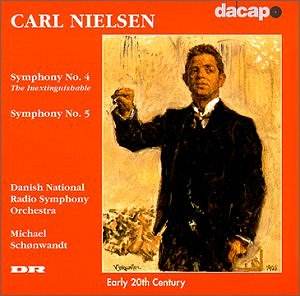Carl NIELSEN
Symphony No. 4 (The Inextinguishable)
Symphony No. 5
 Danish National Radio Symphony
Orchestra - Michael Schonwandt
Danish National Radio Symphony
Orchestra - Michael Schonwandt
recorded in the Danish Radio Concert Hall - 21-22/10/99 (No.4) and 26-27/9/99
(No. 5).
 DaCapo 8.224156 [75.56]
DDD
DaCapo 8.224156 [75.56]
DDD

This disc deserves a very wide circulation. It has a sweep and a feeling
that everything is right about it that minor niggles are silenced. It can
be compared to English orchestras playing Elgar and Vaughan Williams, or
American ensembles playing Copland, Harris and the like. Is it the performance
we have all been waiting for ?, well, not exactly.
There is evidence that an extra patching session or so might have removed
one or two tiny imperfections. The playing of the orchestra is not quite
in the same high class as the San Francisco Symphony Orchestra's standard
on Decca, but the differences are so small as not to make a difference. The
recording, not in the top of the drawer Hi-Fi standard of the Decca, sounds
here, more like a real orchestra in a concert hall, indeed more like a very
good BBC recording, recorded close enough to pick up the detail, but far
enough away not to spoil the effect of a real orchestra playing between the
speakers. For some, this would be a drawback, but for this reviewer, these
are all plusses. Here, both the sound of the orchestra and its ability to
evoke the atmosphere of both works is clearly evident, and I had much enjoyment
from the disc. So much so that after hearing this recording, I promptly went
out and bought the earlier issue, coupling Symphonies 2 and 3!! I enjoyed
this just as much.
Symphony No. 4, which opens the disc, starts with a very strong first movement,
getting the symphony off to a good start. The Danish woodwinds make a lovely
noise, and the quasi rustic flavour of the writing is fully realised here.
When it is a shame to often find nowadays that many orchestras are losing
their national characteristics as players and music schools become more
international, it is very pleasing to note that these characteristics haven't
completely disappeared with this orchestra. It is also pleasing to note that
this flavour has been admirably caught by the engineers.
There follows the interlude, dominated by those delightful sounding woodwinds.
The passionate slow movement follows, culminating in an extended fugue, topped
by an intensive climax. This subsides and we are then prepared for the finale,
which must have shook early audiences to the core with its intensity and
violence. After an introduction, with extremely animated rushing passages
for massed strings, there starts the conflict between the orchestra and the
timpani. The normal orchestral set of drums are complemented by another set
on the opposite side of the orchestra, and these toss conflict back and forth
between them. At this stage in the work, the hairs on the back of my neck
were standing to attention, such was the intensity of the argument by Schonwant
and his players.
Moving on to the 5th Symphony (untitled) we have Nielsen's major
exposition of conflict, having as it does the battle between the full orchestra
and a completely wayward side drum. The player has instructions from the
composer to disrupt the proceedings of the orchestra in its progress towards
its goal, whatever the consequences. I have heard some live performances
where that nearly happened, but in a studio recording the outcome is quite
predictable. Here the conflict is graphically presented, and the truthfulness
of the recording supports the effects. The finale then opens joyfully, and
progresses to a very satisfying conclusion.
Well done Michael Schonwandt, the Royal Danish Radio Orchestra, and DaCapo
completing the issue with an excellent set of notes.
John Phillips

see also review by Terry Barfoot
